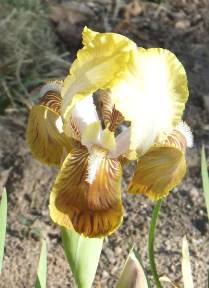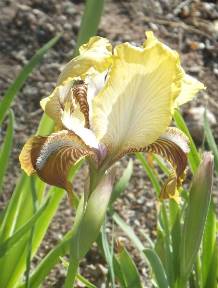|

|
Turkish Topaz
|
 'Turkish Topaz' was introduced by Lloyd Austin in 1962, but was not
registered until 1976. Although parentage was not included in the
official registration data, Austin described it as coming from a
cross of "two stolonifera seedlings", and it was registered as
a Regelia hybrid (RH). The phrase "stolonifera seedling" does
not imply pure Iris stolonifera; it could just as well apply
to open-pollinated seedlings.
'Turkish Topaz' was introduced by Lloyd Austin in 1962, but was not
registered until 1976. Although parentage was not included in the
official registration data, Austin described it as coming from a
cross of "two stolonifera seedlings", and it was registered as
a Regelia hybrid (RH). The phrase "stolonifera seedling" does
not imply pure Iris stolonifera; it could just as well apply
to open-pollinated seedlings.
Most growers of this cultivar seem to regard
it as an arilbred; its growth habit suggests it may be an RB+.
Strangely, though, a chromosome count by Freeman Yendall
(ASI Yearbook 1970) gave 2n=43, a result hard to explain
if a set of TB chromosomes is present. I have therefore listed it
among the tetraploid arils, although with considerable reservation.
The flower is not typical of Iris stolonifera; there are no
beards on the standards and the fall beards are very thick and bushy,
as seen in bearded irises.
If a tetraploid aril, it would be expected to
be fully fertile. In April of 2011, John Baumfalk posted to the SRGC
forum
I am growing a seedling of Ed
Pickin's that is "Turkish Topaz x At the Threshold". Turkish Topaz
has never been fertile for anyone but Ed had not heard
this.
Even if it is an unbalanced tetraploid, it
may produce AA gametes and thus act as a tetraploid on
occasion. It does produce normal-looking anthers with plentiful
pollen. However, I have never had a successful cross with it. I
eventually discarded it, as it seems strongly virus infected, is
unsightly out of bloom, and seems to have little to offer compared
with verified tetraploid Regelias.
Tom
Waters
September 2011
Updated April
2016
Unless otherwise noted, all text
and illustrations copyright Tom Waters and all photographs copyright
Tom or Karen Waters. Please do not reproduce without
permission.
 'Turkish Topaz' was introduced by Lloyd Austin in 1962, but was not
registered until 1976. Although parentage was not included in the
official registration data, Austin described it as coming from a
cross of "two stolonifera seedlings", and it was registered as
a Regelia hybrid (RH). The phrase "stolonifera seedling" does
not imply pure Iris stolonifera; it could just as well apply
to open-pollinated seedlings.
'Turkish Topaz' was introduced by Lloyd Austin in 1962, but was not
registered until 1976. Although parentage was not included in the
official registration data, Austin described it as coming from a
cross of "two stolonifera seedlings", and it was registered as
a Regelia hybrid (RH). The phrase "stolonifera seedling" does
not imply pure Iris stolonifera; it could just as well apply
to open-pollinated seedlings.
